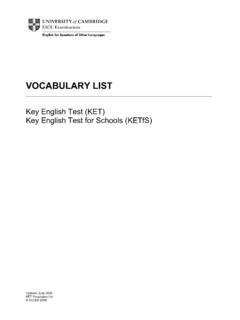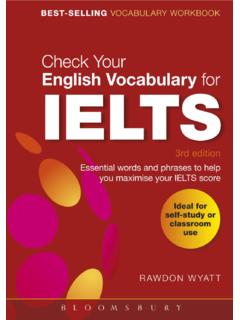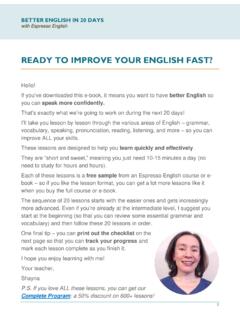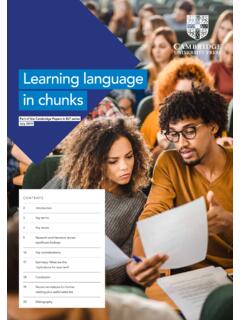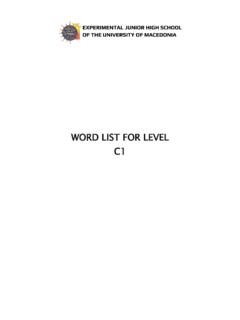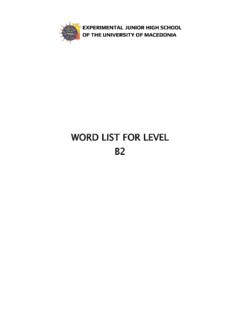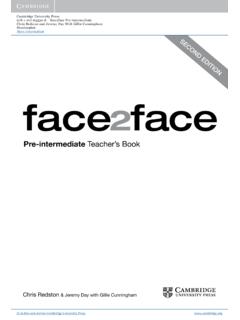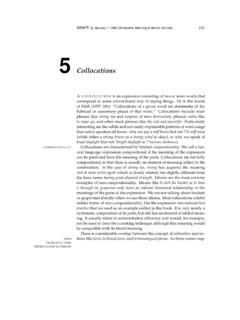Transcription of THE OXFORD 3000 AND OXFORD 5000 - oup.com.cn
1 THE OXFORD 3000 AND OXFORD 5000 THE MOST IMPORTANT WORDS TO LEARN IN ENGLISHTHE EXPERTS CONSULTED FOR THIS PAPERMARLISE HORSTM arlise Horst is Associate Professor Emerita of Applied Linguistics at Concordia University in Montreal, Canada. Her research focuses on second language vocabulary acquisition. She is the author of Focus on Vocabulary (2019). She has recently completed an ESL coursebook for Maison de l amiti , a community centre in Montreal where she once trained intern teachers and now teaches a class one evening a week. Her career has taken her to Egypt, Saudi Arabia, Oman, Hong Kong, Canada, and most recently to Tokyo, where she enjoyed teaching a graduate course on second language vocabulary MILTONJ ames Milton is Professor of Applied Linguistics at Swansea University, UK.
2 After teaching in Nigeria and Libya, he established the Centre for Applied Language Studies and the Department of Applied Linguistics in Swansea in 1985. He also works on publishing and consultancy projects both in the UK and around the world, including China, South Korea, Singapore, Greece, and Italy. His main areas of interest are second language acquisition, vocabulary learning, and the mental lexicon. His publications include Dimensions of Vocabulary Knowledge (2014, with Tess Fitzpatrick), Measuring Second Language Vocabulary Acquisition (2009), and Modelling and Assessing Vocabulary Knowledge (2007, with Helmut Daller and Jeanine Treffers-Daller).
3 PAUL NATIONPaul Nation is Emeritus Professor of Applied Linguistics in the School of Linguistics and Applied Language Studies at Victoria University of Wellington, New Zealand. He has taught in Indonesia, Thailand, Japan, the USA, and Finland. His publications include How Vocabulary is Learned (2017, with Stuart Webb), Making and Using Word lists for Language Learning and Testing (2016), and Learning Vocabulary in Another Language (2013, 2nd edition). Many free resources for teachers and researchers, including word lists , vocabulary tests, articles, and resources for reading can be found on his website (see Further reading and resources).
4 Julie Moore is a freelance ELT writer, lexicographer, and corpus researcher based in Bristol, UK. Her specialist area of interest is teaching vocabulary. She has worked on a number of learner s dictionaries and other vocabulary resources, including the OXFORD Learner s Dictionary of Academic English (2014), OXFORD Academic Vocabulary Practice (2017), and ETpedia Vocabulary (2019, with Fiona Mauchline and Stacey Hughes). She is also a regular conference speaker and teacher THE AUTHOR2 OXFORD University Press Introduction 4 01 Vocabulary development and language learning 5 02 Revising the OXFORD 3000 and creating the OXFORD 5000 7 03 The OXFORD Learner s Word lists and the CEFR 10 04 How the revised OXFORD 3000 supports learners 13 05 Using the OXFORD Learner s Word lists 15 Conclusions 20 Appendix 21 Further reading and resources 22 Endnotes and references 23 CONTENTS OXFORD University Press3
5 Vocabulary acquisition is a key aspect of language learning, but not all words are equally important to know. Which words will be immediately useful to learners and help them achieve their communicative aims at different points in the language learning journey? How can teachers and learners focus on the high-frequency, high-value words that are especially worth attention in language teaching and learning? Which words are appropriate to learn at different language levels? This paper addresses these questions in the context of the OXFORD Learner s Word word lists the OXFORD 3000 , the OXFORD 5000 , the OXFORD Phrase List, the OXFORD phrasal Academic Lexicon, and topic lists have been designed to help English language learners at any level focus on the most important words and phrases to learn.
6 (The Appendix provides further information on each of the different word lists .)In Section 1, vocabulary acquisition is briefly discussed in the context of high-frequency vocabulary and the revised OXFORD 3000 , emphasizing the value for teachers and learners of focusing their efforts on the most useful words to Section 2, important features of the revised OXFORD 3000 and the new OXFORD 5000 are explained. The revisions made to the OXFORD 3000 were prompted by the growing need among learners for immediately useful language to support their language learning goals and by the changing use of language.
7 The new OXFORD 5000 was created to meet the vocabulary learning needs of advanced learners. There is also a brief introduction to the OXFORD Phrase List, which supports learners in taking their vocabulary learning beyond individual words. INTRODUCTIONIn Section 3, vocabulary development and the CEFR are discussed, in particular how CEFR levels were assigned to the OXFORD 3000 and the OXFORD 5000 . The importance of revisiting and recycling vocabulary that has been learned as a way of reinforcing learning is also Section 4, the benefits for learners of using the OXFORD 3000 for vocabulary learning are discussed.
8 In particular, the ways in which it provides coverage of high-frequency, high-value words; ensures comprehension across a range of text types; allows learners to track their progress; and introduces new words, new uses of words, and increased coverage of topic Section 5, ways of using the OXFORD Learner s Word lists to guide learning to develop a vocabulary syllabus, create classroom materials, and for self-study are explored. Through discussion and analysis, this paper explores the development of the OXFORD Learner s Word lists . It sets out some of the practical ways in which they can help guide syllabus designers, materials writers, teachers, and learners to focus vocabulary learning around high-frequency, high-value words that will provide high returns for the time and effort spent on the vocabulary of a new language is an enormous challenge.
9 Teachers may feel a heavy burden of responsibility, but with it comes the potential to bring about positive change. Knowing vocabulary empowers language HORST4 OXFORD University PressVOCABULARY DEVELOPMENT AND LANGUAGE LEARNINGW ords are the basic building blocks of language and, for any learner, acquiring vocabulary is a key part of developing their language skills. Vocabulary size is also one of the most useful indicators of overall language Learners vary in terms of exactly how their vocabularies develop, depending, for example, on age, context, or motivation, but typically vocabulary grows gradually as a learner s general language level MOST FREQUENT WORDS IN ENGLISH Table 1 shows learners approximate vocabulary size at different levels of the Common European Framework of Reference (CEFR)
10 In terms of their knowledge of the 5,000 most frequent words, measured as part of a large study of students taking exams linked to the CEFR. It indicates that considerable knowledge of these most frequent words is required to get to A1 and then to A2 level, but after that the rate of progress appears to be fairly consistent, with around 500 words being added at each CEFR LevelNumber of words known out of the most frequent 5,000A1<1,50 0A21,500 2,500B12,500 3,250B23,250 3,750C13,750 4,500C24,500 5,000 Table 1. The CEFR and vocabulary size (adapted from Milton, 2009, p.)
